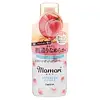What's inside
What's inside
 Key Ingredients
Key Ingredients

 Benefits
Benefits

 Concerns
Concerns

 Ingredients Side-by-side
Ingredients Side-by-side

Water
Skin ConditioningPropylene Glycol
HumectantDimethicone
EmollientMyristyl Alcohol
EmollientButylene Glycol
HumectantAlcohol Denat.
AntimicrobialEthylhexylglycerin
Skin ConditioningGamma-Docosalactone
Skin ConditioningGlycerin
HumectantSteartrimonium Chloride
PreservativeCaprylic/Capric Triglyceride
MaskingHydroxyethylcellulose
Emulsion StabilisingPhenoxyethanol
PreservativeBehentrimonium Chloride
PreservativePrunus Persica Fruit Extract
AbrasiveDisodium EDTA
Aroma
Water, Propylene Glycol, Dimethicone, Myristyl Alcohol, Butylene Glycol, Alcohol Denat., Ethylhexylglycerin, Gamma-Docosalactone, Glycerin, Steartrimonium Chloride, Caprylic/Capric Triglyceride, Hydroxyethylcellulose, Phenoxyethanol, Behentrimonium Chloride, Prunus Persica Fruit Extract, Disodium EDTA, Aroma
Water
Skin ConditioningDipropylene Glycol
HumectantCetyl Ethylhexanoate
EmollientCetearyl Alcohol
EmollientCetyl Alcohol
EmollientDimethicone
EmollientDicaprylyl Carbonate
EmollientCyclopentasiloxane
EmollientStearamidopropyl Dimethylamine
EmulsifyingAmodimethicone
Cetyl Esters
EmollientParfum
MaskingPPG-3 Caprylyl Ether
SolventLactic Acid
BufferingDimethiconol
EmollientArginine
MaskingMaleic Acid
BufferingButylene Glycol
HumectantGlyceryl Caprylate
EmollientRosa Damascena Flower Water
MaskingTrideceth-10
CleansingEthylhexylglycerin
Skin ConditioningDisodium EDTA
Polyquaternium-51
Skin ConditioningPhenoxyethanol
Preservative1,2-Hexanediol
Skin ConditioningCamellia Japonica Seed Oil
EmollientCarthamus Tinctorius Flower Extract
Skin ConditioningDextrin
AbsorbentVitis Vinifera Seed Oil
EmollientCaprylic/Capric Triglyceride
MaskingGlyceryl Linoleate
EmollientAcetic Acid
BufferingCapsicum Annuum Extract
MaskingGlyceryl Linolenate
EmollientMalt Extract
Skin ProtectingTocopherol
AntioxidantGlyceryl Arachidonate
EmollientMacadamia Ternifolia Seed Oil
EmollientSorbitol
HumectantBiotin
AntiseborrhoeicAscorbyl Palmitate
AntioxidantCaprylyl Glycol
EmollientLimonene
PerfumingCI 40800
Cosmetic ColorantWater, Dipropylene Glycol, Cetyl Ethylhexanoate, Cetearyl Alcohol, Cetyl Alcohol, Dimethicone, Dicaprylyl Carbonate, Cyclopentasiloxane, Stearamidopropyl Dimethylamine, Amodimethicone, Cetyl Esters, Parfum, PPG-3 Caprylyl Ether, Lactic Acid, Dimethiconol, Arginine, Maleic Acid, Butylene Glycol, Glyceryl Caprylate, Rosa Damascena Flower Water, Trideceth-10, Ethylhexylglycerin, Disodium EDTA, Polyquaternium-51, Phenoxyethanol, 1,2-Hexanediol, Camellia Japonica Seed Oil, Carthamus Tinctorius Flower Extract, Dextrin, Vitis Vinifera Seed Oil, Caprylic/Capric Triglyceride, Glyceryl Linoleate, Acetic Acid, Capsicum Annuum Extract, Glyceryl Linolenate, Malt Extract, Tocopherol, Glyceryl Arachidonate, Macadamia Ternifolia Seed Oil, Sorbitol, Biotin, Ascorbyl Palmitate, Caprylyl Glycol, Limonene, CI 40800
 Reviews
Reviews

Ingredients Explained
These ingredients are found in both products.
Ingredients higher up in an ingredient list are typically present in a larger amount.
Butylene Glycol (or BG) is used within cosmetic products for a few different reasons:
Overall, Butylene Glycol is a safe and well-rounded ingredient that works well with other ingredients.
Though this ingredient works well with most skin types, some people with sensitive skin may experience a reaction such as allergic rashes, closed comedones, or itchiness.
Learn more about Butylene GlycolThis ingredient is an emollient, solvent, and texture enhancer. It is considered a skin-softener by helping the skin prevent moisture loss.
It helps thicken a product's formula and makes it easier to spread by dissolving clumping compounds.
Caprylic Triglyceride is made by combining glycerin with coconut oil, forming a clear liquid.
While there is an assumption Caprylic Triglyceride can clog pores due to it being derived from coconut oil, there is no research supporting this.
Learn more about Caprylic/Capric TriglycerideDimethicone is a type of synthetic silicone created from natural materials such as quartz.
What it does:
Dimethicone comes in different viscosities:
Depending on the viscosity, dimethicone has different properties.
Ingredients lists don't always show which type is used, so we recommend reaching out to the brand if you have questions about the viscosity.
This ingredient is unlikely to cause irritation because it does not get absorbed into skin. However, people with silicone allergies should be careful about using this ingredient.
Note: Dimethicone may contribute to pilling. This is because it is not oil or water soluble, so pilling may occur when layered with products. When mixed with heavy oils in a formula, the outcome is also quite greasy.
Learn more about DimethiconeDisodium EDTA plays a role in making products more stable by aiding other preservatives.
It is a chelating agent, meaning it neutralizes metal ions that may be found in a product.
Disodium EDTA is a salt of edetic acid and is found to be safe in cosmetic ingredients.
Learn more about Disodium EDTAEthylhexylglycerin (we can't pronounce this either) is commonly used as a preservative and skin softener. It is derived from glyceryl.
You might see Ethylhexylglycerin often paired with other preservatives such as phenoxyethanol. Ethylhexylglycerin has been found to increase the effectiveness of these other preservatives.
Phenoxyethanol is a preservative that has germicide, antimicrobial, and aromatic properties. Studies show that phenoxyethanol can prevent microbial growth. By itself, it has a scent that is similar to that of a rose.
It's often used in formulations along with Caprylyl Glycol to preserve the shelf life of products.
Water. It's the most common cosmetic ingredient of all. You'll usually see it at the top of ingredient lists, meaning that it makes up the largest part of the product.
So why is it so popular? Water most often acts as a solvent - this means that it helps dissolve other ingredients into the formulation.
You'll also recognize water as that liquid we all need to stay alive. If you see this, drink a glass of water. Stay hydrated!
Learn more about Water